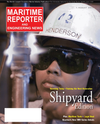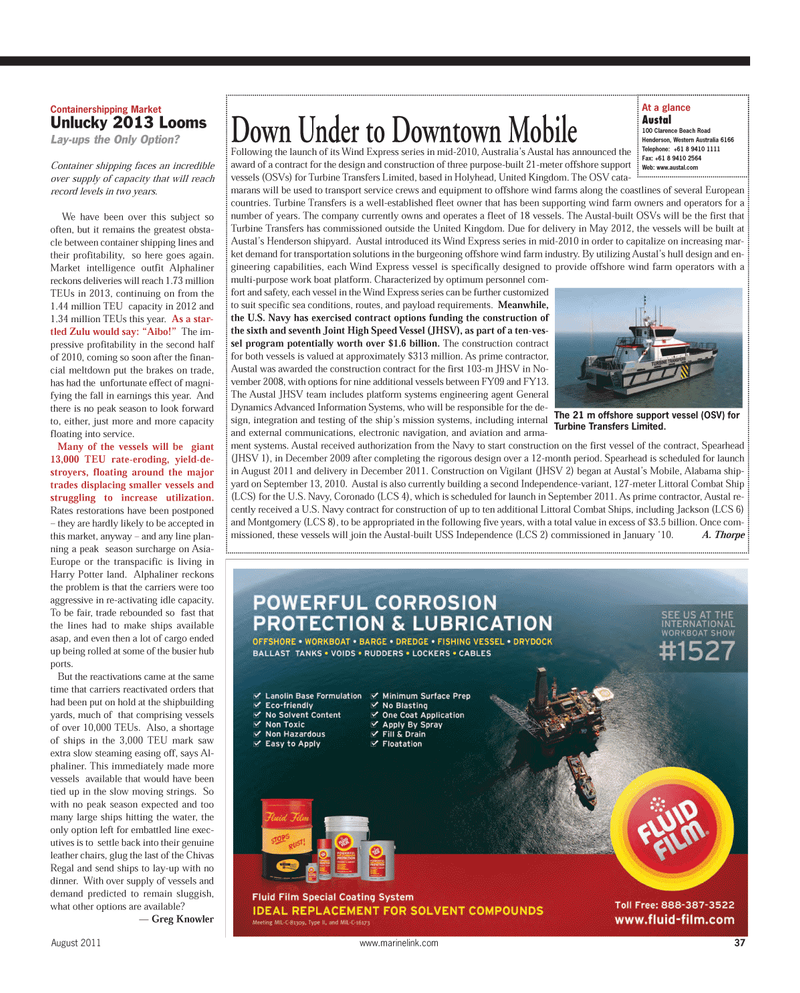
Page 37: of Maritime Reporter Magazine (August 2011)
Top 20 Shipyards of the World
Read this page in Pdf, Flash or Html5 edition of August 2011 Maritime Reporter Magazine
Containershipping MarketUnlucky 2013 Looms Lay-ups the Only Option?Container shipping faces an incredible over supply of capacity that will reach record levels in two years. We have been over this subject so often, but it remains the greatest obsta- cle between container shipping lines andtheir profitability, so here goes again. Market intelligence outfit Alphaliner reckons deliveries will reach 1.73 million TEUs in 2013, continuing on from the1.44 million TEU capacity in 2012 and 1.34 million TEUs this year. As a star- tled Zulu would say: ?Aibo!? The im-pressive profitability in the second half of 2010, coming so soon after the finan- cial meltdown put the brakes on trade, has had the unfortunate effect of magni- fying the fall in earnings this year. And there is no peak season to look forward to, either, just more and more capacity floating into service. Many of the vessels will be giant 13,000 TEU rate-eroding, yield-de- stroyers, floating around the major trades displacing smaller vessels and struggling to increase utilization. Rates restorations have been postponed ? they are hardly likely to be accepted in this market, anyway ? and any line plan- ning a peak season surcharge on Asia- Europe or the transpacific is living in Harry Potter land. Alphaliner reckons the problem is that the carriers were tooaggressive in re-activating idle capacity. To be fair, trade rebounded so fast that the lines had to make ships available asap, and even then a lot of cargo ended up being rolled at some of the busier hub ports. But the reactivations came at the same time that carriers reactivated orders that had been put on hold at the shipbuilding yards, much of that comprising vessels of over 10,000 TEUs. Also, a shortage of ships in the 3,000 TEU mark saw extra slow steaming easing off, says Al- phaliner. This immediately made more vessels available that would have been tied up in the slow moving strings. So with no peak season expected and too many large ships hitting the water, the only option left for embattled line exec- utives is to settle back into their genuine leather chairs, glug the last of the Chivas Regal and send ships to lay-up with no dinner. With over supply of vessels and demand predicted to remain sluggish,what other options are available? ? Greg Knowler August 2011www.marinelink.com 37Down Under to Downtown Mobile Following the launch of its Wind Express series in mid-2010, Australia?s Austal has announced the award of a contract for the design and construction of three purpose-built 21-meter offshore support vessels (OSVs) for Turbine Transfers Limited, based in Holyhead, United Kingdom. The OSV cata- marans will be used to transport service crews and equipment to offshore wind farms along the coastlines of several European countries. Turbine Transfers is a well-established fleet owner that has been supporting wind farm owners and operators for a number of years. The company currently owns and operates a fleet of 18 vessels. The Austal-built OSVs will be the first that Turbine Transfers has commissioned outside the United Kingdom. Due for delivery in May 2012, the vessels will be built at Austal?s Henderson shipyard. Austal introduced its Wind Express series in mid-2010 in order to capitalize on increasing mar- ket demand for transportation solutions in the burgeoning offshore wind farm industry. By utilizing Austal?s hull design and en -gineering capabilities, each Wind Express vessel is specifically designed to provide offshore wind farm operators with a multi-purpose work boat platform. Characterized by optimum personnel com- fort and safety, each vessel in the Wind Express series can be further customized to suit specific sea conditions, routes, and payload requirements. Meanwhile,the U.S. Navy has exercised contract options funding the construction of the sixth and seventh Joint High Speed Vessel (JHSV), as part of a ten-ves- sel program potentially worth over $1.6 billion. The construction contractfor both vessels is valued at approximately $313 million. As prime contractor, Austal was awarded the construction contract for the first 103-m JHSV in No- vember 2008, with options for nine additional vessels between FY09 and FY13. The Austal JHSV team includes platform systems engineering agent General Dynamics Advanced Information Systems, who will be responsible for the de- sign, integration and testing of the ship?s mission systems, including internal and external communications, electronic navigation, and aviation and arma- ment systems. Austal received authorization from the Navy to start construction on the first vessel of the contract, Spearhead (JHSV 1), in December 2009 after completing the rigorous design over a 12-month period. Spearhead is scheduled for launch in August 2011 and delivery in December 2011. Construction on Vigilant (JHSV 2) began at Austal?s Mobile, Alabama ship- yard on September 13, 2010. Austal is also currently building a second Independence-variant, 127-meter Littoral Combat Ship (LCS) for the U.S. Navy, Coronado (LCS 4), which is scheduled for launch in September 2011. As prime contractor, Austal re- cently received a U.S. Navy contract for construction of up to ten additional Littoral Combat Ships, including Jackson (LCS 6) and Montgomery (LCS 8), to be appropriated in the following five years, with a total value in excess of $3.5 billion. Once com- missioned, these vessels will join the Austal-built USS Independence (LCS 2) commissioned in January ?10. A. ThorpeAt a glanceAustal100 Clarence Beach Road Henderson, Western Australia 6166 Telephone: +61 8 9410 1111 Fax: +61 8 9410 2564Web: www.austal.com The 21 m offshore support vessel (OSV) for Turbine Transfers Limited. MR Aug. 11 # 5 (34-41):MR Template 8/5/2011 9:25 AM Page 37

 36
36

 38
38
